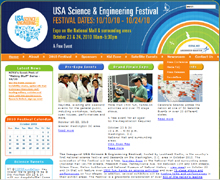
The USA Science & Engineering Festival culminates this weekend, October 23-24, with a ginormous Expo featuring over 1,500 fun activities on the National Mall in Washington, DC.
The Science for Citizens team will be there to host our very own exhibit, which will feature several partner citizen science organizations and opportunities to participate in real, hands-on scientific research. The event is free, open to all ages, and requires absolutely no pre-registration. If you’re in the DC area this weekend, stop by and join us!
Our booth will be located at Section PA-13, Booth Number(s) 1229 & 1231, on Pennsylvania Ave NW between 13th and 14th St [Google Maps link].
All this week, we’re featuring a short Q&A with our collaborators so you’ll know what to expect when you get to the Festival. First up is Anne from Earthwatch!

Anne, tell us about yourself.
I am the coordinator of Earthwatch’s New York City (NYC) Coyote project and also the volunteer citizen science coordinator for WildMetro, a grassroots nature-based research and educational organization in NYC.
What are the goals of Earthwatch’s NYC Coyote Project?
We have been working in the NYC metropolitan area (the Bronx and Westchester counties) to determine coyote presence in parks and natural areas. As an Earthwatch project, we involve citizen scientists in collecting the data (deploying and taking down camera traps, setting up hair-trap stations, doing call-back surveys), as well as in basic data analysis (going through the collected images). To date we have confirmed coyote presence in five of the seven parks we have been working in.
What can people expect to learn at the Science for Citizens booth?
At the USA Science and Engineering Festival, we will be playing the recordings of the different sounds that coyotes make in the wild and sharing some of the images collected from our camera trap stations. We have developed a regional map of coyote sightings in the NYC area and will be on site to explain how eastern coyotes are different from their western counterparts, and the efforts made by scientists (and citizens) to understand urban coyotes.
What is your favorite part about working in citizen science?
Something special happens when you are out in the field doing scientific research. On one hand, you are thinking, asking questions, coming up with new ideas – What if we put the camera here? How would an animal react to this research method? You learn to think in a different way, from a different perspective… a ‘wilder’ look at the world, perhaps… On the other hand, you are experiencing nature in a direct way that doesn’t always translate to a cognitive thought process… It is more of an emotional connection, a “feeling” that you begin to have about nature and its processes.
Up until very recently, this experience was one that only scientists and naturalists had. Citizen science brings this experience to the rest of us who don’t have advanced degrees in Biology or Ecology. Fieldwork is inherently mentally and physically draining, but in working with citizen scientists I’ve noticed how both scientists and participants come away from the project with renewed energy for continuing to find answers to unsolved questions, to keep at it… It is about learning together – not just at the same time, but from one another as well.

